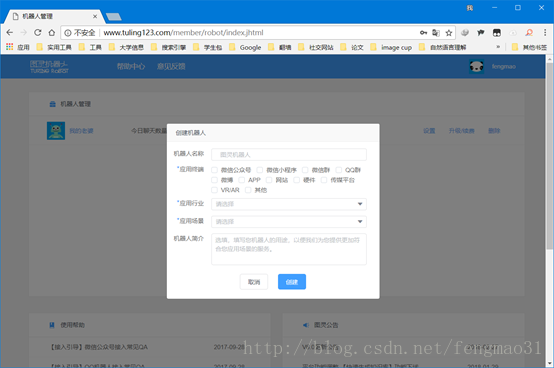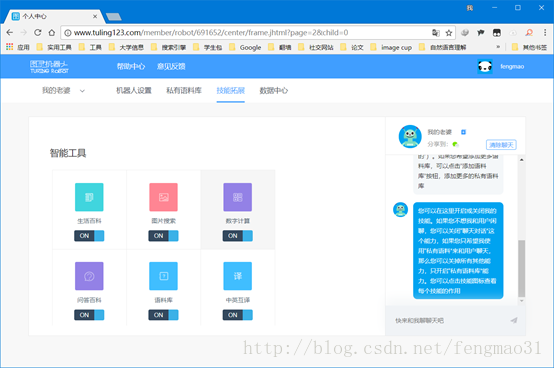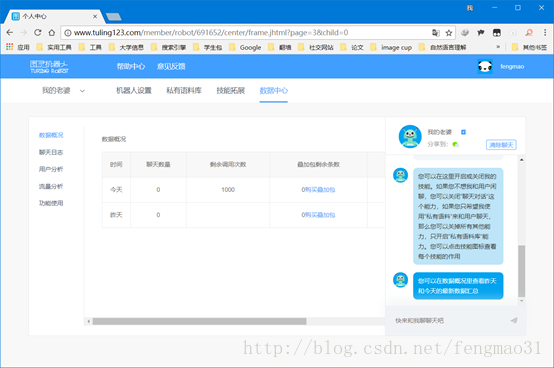1 百度语音模块
参考http://blog.csdn.net/u011118482/article/details/55001444
1.1 百度语音识别包
git clonehttps://github.com/DinnerHowe/simple_voice.git
在catkin下编译
1.2 安装pyaudio播放器
sudo apt-get install python-pyaudio
1.3 安装python所需环境
sudo apt-get install vlc
1.4 测试安装
roslaunch simple_voicesimple_voice.launch
测试语音合成
rostopic pub /speak_string std_msgs/String-- '请让一下'
会在home中生成Xbot文件,里面按合成的语句的固定字节截断作为名字存放下载的合成语音。如果两段话前几句相同,会相互覆盖。
roslaunch simple_voice simple_voice.launch
1.5 建议
可以改写成服务比节点好。
2 图灵聊天机器人模块
图灵机器人只支持一轮对话,而且不提供sdk,如果有条件可以自己开发聊天机器人。
目前聊天机器人基本还是模板匹配,依靠检索问答,使用通配符或者文本相似度。
目前免费,收费版也很便宜,免费版有次数限制。
1.1 注册

1.2 机器人个性

设置一些属性,以及在线训练。
1.3 私有语料库
语料库基于相似度匹配,但有时智障,一摸一样的句子,它会回答自己的语料库,而不是你的私有语料库
1.4 机器人技能

机器人的一些技能拓展。
1.5 后台分析

1.6 图灵聊天机器人原理
问句输入后,进入筛选器,筛出机器人技能,就是计算和天气之类的,匹配使用文本相似度。中间可以使用一些特定命令进入一些成语接龙游戏。
以检索式结构为主,应用一些机器学习处理。
数据来源是爬取的百度知道,百科,可能有各大论坛,和以前人人网小黄鸡的语料。
3 聊天机器人搭建
在百度语音包中新建start.py。之后运行
rosrun baidu_speech start.py
#!/usr/bin/env python
# -*- coding: utf-8 -*-
import rospy
from std_msgs.msg import String
from simple_voice.srv import *
import urllib
import json
state = 0
LAN = 0
file_strs =[]
def getHtml(url):
page = urllib.urlopen(url)
html = page.read()
return html
def listener():
rospy.Subscriber("Rog_result", String, callback)
rospy.spin()
def str_fix(str):
global file_strs
result = ""
for file_str in file_strs:
file_strs_left= file_str.split('|')[0]
strs = file_strs_left.split(',')
b = True
for ele in strs:
if ele not in str:
b=False
break
if b:
pub_msg(file_str.split('|')[2])
return file_str.split('|')[1]
return str
def callback(data):
words=data.data
if words !='识别错误':
s=get_ans(words)
pub.publish(s)
rospy.loginfo(s)
def get_ans(info):
key = '###############此处为密钥###################'
api = 'http://www.tuling123.com/openapi/api?key=' + key + '&info='
request = api + info
response = getHtml(request)
dic_json = json.loads(response)
result = dic_json['text']
return result
if __name__ == '__main__':
rospy.init_node("Main")
rospy.loginfo('开始')
pub = rospy.Publisher('speak_string', String, queue_size=10)
# str=raw_input("press to publish")
listener()
4 案例源码
https://github.com/fengmao31/ros-demo



